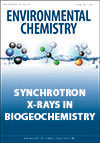
Environmental Chemistry
Volume 11 Number 1 2014
RESEARCH FRONT: Synchrotron X-rays in Biogeochemistry
EN13162Scaling up: fulfilling the promise of X-ray microprobe for biogeochemical research
Environmental context. Although biogeochemical processes in the environment are often considered on large spatial scales, critical processes can occur at fine-spatial scales. Quantifying these processes is a challenge, but significant recent developments in microprobe X-ray absorption spectroscopy in terms of data collection and analysis greatly facilitate micro-scale observations at the sample-level. These mapping methods create datasets that can be integrated with bulk observations with the potential for widespread application to biogeochemical research.
EN13075Visualising Fe speciation diversity in ocean particulate samples by micro X-ray absorption near-edge spectroscopy
Environmental context. Iron-bearing particles in the ocean have attracted interest due to the role of iron as an essential nutrient for microscopic algae, which form the base of the marine food chain. Modern techniques make it possible to analyse individual particles of iron to determine their composition, but the resulting flood of data can be overwhelming. We show a method of simplifying the data to answer such questions as what groups of minerals are present and whether they are different between ocean basins.
EN13129Effect of biogeochemical redox processes on the fate and transport of As and U at an abandoned uranium mine site: an X-ray absorption spectroscopy study
Environmental context. Uranium and arsenic, two elements of human health concern, are commonly found at sites of uranium mining, but little is known about processes influencing their environmental behaviour. Here we focus on understanding the chemical and physical processes controlling uranium and arsenic transport at an abandoned uranium mine. We find that the use of sedimentation ponds limits the mobility of uranium; however, pond conditions at our site resulted in arsenic mobilisation. Our findings will help optimise restoration strategies for mine tailings.
EN13082Synchrotron X-ray distinction of seasonal hydrological and temperature patterns in speleothem carbonate
Environmental context. Speleothem chemical records are used to reconstruct environmental change on a broad range of timescales. However, one of the biggest challenges is to link the records contained within speleothems at the sub-annual timescale to changing meteorological conditions. Seasonal infiltration patterns and cave ventilation dynamics are reconstructed through high resolution analysis of speleothem trace element content by synchrotron radiation, building towards proxy records of hydrological variability and winter duration as indices of recent climatic change beyond the instrumental period.
EN13106Diffusion limitation of zinc fluxes into wheat roots, PLM and DGT devices in the presence of organic ligands
Environmental context. Zinc is an essential micronutrient for plants and many arid areas of the world have zinc-deficient soils. The bioavailability of Zn to plants is influenced by diffusion limitations and complex lability in the soil solution. To identify the relative importance of these two factors, we investigated the influence of diffusion layer thickness on Zn uptake by wheat and by two bio-mimetic devices in the presence of ethylenediaminetetraacetic acid and two natural ligands found in soil.
EN13098Photolysis and TiO2-catalysed degradation of diclofenac in surface and drinking water using circulating batch photoreactors
Environmental context. Diclofenac, a common non-steroidal anti-inflammatory drug, is not completely removed from surface and drinking water by conventional treatment methods. Consequently, this drug is present in the aquatic environment and has been subsequently linked to toxic effects on organisms. We show that photolysis and TiO2-catalysed degradation in circulating batch reactors efficiently results in diclofenac removal under a variety of conditions. These photochemical methods thus may lead to more effective water treatment processes.
EN13163A method to determine silver partitioning and lability in soils
Environmental context. Soils contaminated with silver can have detrimental environmental effects because of silver’s toxicity to a range of soil-dwelling organisms. The total concentration of silver in soil, however, is often not a good indicator of potential toxicity as it does not account for variations in bioavailability. We report a method for soil analysis that measures the amount of silver available for uptake by soil-dwelling organisms, and hence could provide data that better reflect potential toxicity.
EN13167Solid phase microextraction speciation analysis of triclosan in aqueous media containing sorbing nanoparticles
Environmental context. Speciation analysis of organic compounds in aquatic media is often performed using solid phase microextraction with the assumption that only the free organic form is accumulated. We show that in the presence of silica nanoparticles, this interpretation is confounded by partitioning of nanoparticulate-bound compounds between water and the solid phase, as well as their aggregation at solid–bulk medium interfaces. Equilibrium measurement of the target analyte is feasible if the solid phase is protected by a suitable membrane.
EN13171Australian carbon tetrachloride emissions in a global context
Environmental context. Carbon tetrachloride in the background atmosphere is a significant environmental concern, responsible for ~10 % of observed stratospheric ozone depletion. Atmospheric concentrations of CCl4 are higher than expected from currently identified emission sources: largely residual emissions from production, transport and use. Additional sources are required to balance the expected atmospheric destruction of CCl4 and may contribute to a slower-than-expected recovery of the Antarctic ozone ‘hole’.



